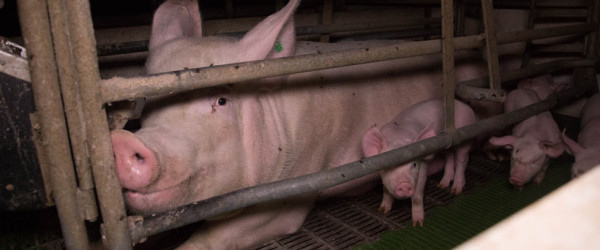
Extreme confinement: The questionable role of the farrowing crate in New Zealand’s future
July 31st, 2018shows the ways in which you can stand up and make a difference.
In their 2016 review of farrowing crates, the National Animal Welfare Advisory Committee (NAWAC) identified significant compliance issues with the current minimum standards. The minimum standard restricts the period of sow confinement to four weeks, except in a small proportion of cases where necessary for piglet health. The industry refused to accept or comply with this standard. Additionally, industry failed to agree or comply with the minimum standard to provide material for sows to manipulate (to undertake nesting behaviour) in recently constructed farrowing systems.
There is far from a scientific consensus around the impact of housing system on piglet survival rates. Of twelve studies investigating piglet survival in different housing systems, two studies showed no difference; pens performed better than crates in five studies; and crates performed better than pens in six studies. Despite this evidence, industry continues to stridently defend the use of crates under the justification of piglet survival rates.
NAWAC emphasises in their review the importance of other factors in reducing piglet mortality. One of the most significant factors being litter size, with smaller litters resulting in larger, healthier piglets who suffer lower mortality. Additionally, reducing stress around farrowing increases piglet survival. This is a clear benefit of providing for nesting behaviour. Selecting for more genetically appropriate pigs, bred for welfare rather than profit, is an obvious step forward and one favoured by NAWAC.
Increasingly, evidence from neuroscience has been filtering into the animal welfare space providing strong support for the experience of emotions in animals and challenging the ability of industry to silence critics with the accusation of anthropomorphism. As we continue to improve our understanding of animals’ affective states society will continue to critically examine our interactions with animals; most importantly, are those interactions where we significantly interfere with an animal’s ability to perform normal behaviours such as through extreme confinement in a farrowing crate.
The pork industry is concerned that they cannot be economically viable if they lift their minimum animal welfare standards. I think they should be much more concerned about the long-term viability of their industry. If they cannot demonstrate compliance with current minimum welfare standards and husbandry practices, which are socially acceptable to the majority of New Zealanders, they will have no future.
The sows of New Zealand need your help so please visit our Online Action Kit for Pigs and make your voice heard.
By Roz Holland, SAFE’s Veterinary Science Advisor
 SAFE Animal Squad
SAFE Animal Squad